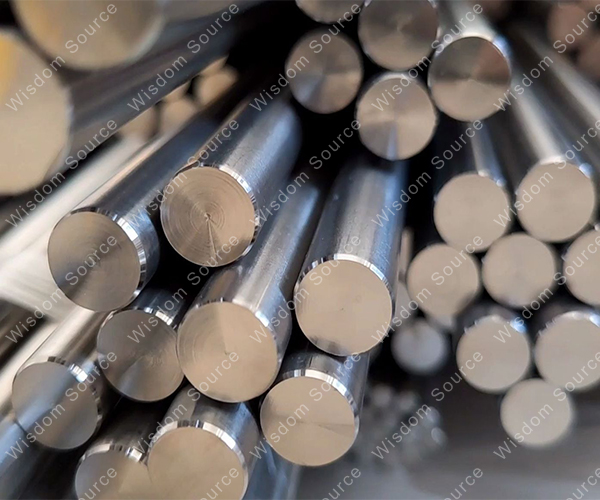Classification And Properties Of High Temperature Titanium Alloys With Various Types Of Titanium Alloys
Classification And Properties Of High Temperature Titanium Alloys With Various Types Of Titanium Alloys
The world's first successfully developed high-temperature titanium alloy is Ti-6Al-4V, with a working temperature of 300-350℃.Subsequently, alloys such as IMI550 and BT3-1 with a temperature of 400℃ have been developed successively, as well as alloys such as IMI679, IMI685, Ti-6246, and Ti-6242 with a temperature of 450~500℃. At present, the new high-temperature titanium alloys that have been successfully used in aircraft engines are.IMI829 and IMI834 alloys from the United Kingdom; Ti-1100 alloys from the United States; BT18Y and BT36 alloys from Russia, etc. In recent years, foreign countries have adopted rapid solidification/powder metallurgy technology, fiber or particle reinforced composite materials to develop titanium alloys as the development direction of high-temperature titanium alloys, so that the use temperature of titanium alloys can be increased to more than 650℃. The United States McDonald's company uses rapid solidification/powder metallurgy technology to successfully develop a high-purity, high-density titanium alloy. Its strength at 760℃ is equivalent to the strength of the titanium alloy currently used at room temperature.

Compared with general titanium alloys, titanium-aluminum compounds are sodium-based Ti3Al (α2) and TiAl (γ) intermetallic compounds. The advantages are good high temperature performance (the operating temperature is 816 and 982℃, respectively), strong oxidation resistance, good creep resistance and light weight (the density is only 1/2 of nickel-based superalloys). These advantages make it a competitive material for aviation engines and aircraft structural parts in the future. At present, two Ti-3Al-based titanium alloys Ti-21Nb-14Al and Ti-24Al-14Nb-#V-0.5Mo have begun mass production in the United States. Other Ti-3Al-based titanium alloys developed in recent years are Ti-24Al-11Nb, Ti-25Al-17Nb-1Mo and Ti-25Al-10Nb-3V-1Mo. The composition range of Ti-Al (γ)-based titanium alloys of concern is TAl-(1-10)M (at.%), where M is at least one element in v, Cr, Mn, Nb, Mn, Mo, and W. Recently, Ti-Al3-based titanium alloys have begun to attract attention, such as Ti-65Al-10Ni alloy.

Β-titanium alloy was first developed by Crucible in the mid-1950s as B120VCA alloy (Ti-13v-11Cr-3Al). Β-type titanium alloy has good hot and cold processing properties, is easy to forge, can be rolled and welded, and can obtain high mechanical properties, good environmental resistance, and a good combination of strength and fracture toughness through solution-aging treatment. There are the following representative types of new high-strength and high-toughness β-titanium alloys: Ti1023 (Ti-10v-2Fe-3Al), which has the same performance as the 30CrMnSiA high-strength structural steel commonly used in aircraft structural parts and has excellent forging properties; Ti153 (Ti-15V-3Cr-3Al-3Sn), the cold-processing performance of the alloy is better than that of industrial pure titanium, and the tensile strength at room temperature after aging can reach more than 1000MPa; β21S (Ti-15Mo-3Al), the cold-processing performance of the alloy is better than that of industrial pure titanium, and the tensile strength at room temperature after aging can reach more than 1000MPa; β21S (Ti-15Mo-3Al) -2.7Nb-0.2Si), this alloy is a new type of oxidation-resistant, ultra-high-strength titanium alloy developed by the Timet division of the American Titanium Company. It has good oxidation resistance and excellent hot and cold processing performance. It can be made into a foil with a thickness of 0.064mm. SP-700 (Ti-4.5Al-3V-2Mo-2Fe) titanium alloy successfully developed by the Japanese Steel Pipe Company (NKK), the alloy has high strength, superplastic elongation as high as 2000%, and the superplastic forming temperature is higher than Ti-6Al- 4V is 140℃ lower, which can replace Ti-6Al-4V alloy and use superplastic molding-diffusion connection (SPF/DB) technology to manufacture various aerospace components; Russia developed BT-22 (TI-5v-5Mo-1Cr-5Al), its tensile strength can reach more than 1105MPA.

Conventional titanium alloys have a tendency to burn alkanes under certain conditions, which greatly limits their application.In response to this situation, various countries have launched research on flame-retardant titanium alloys and made certain breakthroughs.Alloy c (also known as T) developed by Qiangguo has a composition of 50Ti-35v-15Cr (mass fraction), which is a flame-retardant titanium alloy that is not sensitive to continuous combustion and has been used in F119 engines. BTT-1 and BTT-3 are flame-retardant titanium alloys developed in Russia. They are both Ti-Cu-Al alloys, which have quite good thermal deformation process properties and can be used to make complex parts.

Titanium is non-toxic, light in weight, high in strength and has excellent biocom-patibility. It is a very ideal medical metal material and can be used as an implant implanted in the human body. At present, Ti-6Al-4V ELI alloy is still widely used in the medical field.However, the latter will precipitate very small amounts of vanadium and aluminum ions, which reduces its cellular adaptability and may cause harm to the human body. This issue has long attracted widespread attention from the medical community. As early as the mid-1980s, the United States began to develop aluminum-free, vanadium-free, biocom-patible titanium alloys for orthopedics. Japan, the United Kingdom, etc. have also done a lot of research work in this area, and have made some new progress. For example, Japan has developed a series of α+β titanium alloys with excellent biocom-patibility, including Ti-15Zr-4Nb_4ta-0.2Pd, Ti-15Zr-4Nb-aTa-0.2 Pd-0.20~0.05N, Ti-15Sn-4Nb-2Ta-0.2Pd and Ti-15Sn-4Nb-2Ta-0.2Pd-0.20. The corrosion strength, fatigue strength and corrosion resistance of these alloys are better than that of Ti-6Al-4V ELI. Compared with α+β titanium alloy, β titanium alloy has higher strength and water resistance, as well as better incision performance and toughness, and is more suitable for implantation into the human body as an implant. In the United States, five kinds of β-titanium alloys have been recommended for the medical field, namely TMZFTM (TI-12Mo-^Zr-2Fe), Ti-13Nb-13Zr, Timetable 21SRx (TI-15Mo-2.5Nb-0.2 Si), Tiadyne 1610 (Ti-16Nb-9.5Hf) and Ti-15Mo. It is estimated that in the near future, such titanium dioxide alloys with high strength, low elastic modulus, excellent formability and corrosion resistance are likely to replace the Ti-6Al-4V ELI alloys currently widely used in the medical field.
